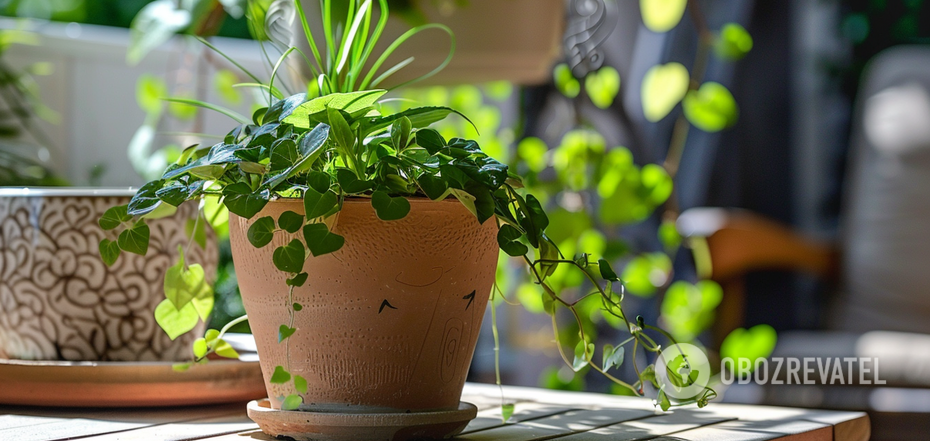News
Which houseplants should be brought outdoors in summer: tips and cautions
In the summer, when nature is in full bloom, you want to give your indoor plants a little fresh air, warm rain and sunshine. And you can indeed do this by taking some of your pots out to the balcony, terrace, or yard.
But experienced gardeners recommend doing it right, because a sharp transition from indirect light from the window to direct summer sun can burn the leaves. OBOZ.UA asked for tips on how to do the transfer correctly. And which plants will feel really good outdoors in summer.
Take your time
When planning the placement of indoor plants outdoors, take into account their needs for sunlight. Those that like direct rays can be safely placed in a sunny spot. But those that need indirect light should also be left in the shade - under a wall or near a large tree.
When you move indoor plants outside for the summer, it is recommended to make the transition gradual. Start with a few hours outdoors a day and place the pots in a shady spot. Leave them outside for 30-60 minutes longer each day and gradually move the sun-loving plants into direct light. After about a week or two, they can be left outside for the rest of the season.
Which plants feel good outdoors
Some indoor plants, such as lyre ficus or monstera, can be very sensitive to changes in the environment. Therefore, it is better to leave them in the house. The species listed below will feel great in the yard or on the balcony.
Indoor palms
These plants are safe for pets and do not require special care, so they are always a good choice for beginners. They will create a pleasant tropical atmosphere and will tolerate direct sunlight. If you have small palms, such as areca or hamedorea, and you want them to grow a little, exposure to the air can speed up the process.
Crotons
Croton is a colorful houseplant with luxurious ornamental foliage decorated with colorful veins and spots. It can also accelerate growth if you take it outside. If this is what you want to achieve, don't forget to fertilize the plant regularly. And watch the summer sun make the bright croton foliage even brighter.
Dieffenbachia
Dieffenbachia is one of the most hardy houseplants, so it can easily move to the balcony. Partial shade is the best place for it. For example, it can be placed in a corner where it is sunny for half of the day and shady for the other half. The plant will also feel good in constant shade. But don't forget to bring it back indoors before the air temperature starts to drop to 15 degrees.
Succulents and cacti
These desert natives love to bask in the summer sun like no other. And they can react to being moved to the yard with impressive flowering. If you move them to direct sunlight, be prepared to water them a little bit almost every day, because the heat evaporates moisture from small pots much faster.
Chlorophytums
Outside the home, these lush shrubs can start to grow at an impressive rate. And not just grow, but put out a mustache of young plants. You can leave them to grow like this, or you can cut them off and plant some new chlorophytums - they will quickly take root in the summer.
Ficus elastica
This particularly hardy ficus species benefits from spending time outdoors in the summer. Its relatives can be picky about changes in light levels, but this plant will really thrive. Just make sure that the roots don't start to break out of the pot. In this case, the ficus will need to be transplanted into a larger container.
Schefflera
If you take the shefflera out to the balcony in summer, you will quickly notice how it begins to grow in height and may even bloom. This is unlikely if the plant remains indoors. This species grows best in bright, indirect light, so place it under a tree crown or in a place where there is shade for at least half a day.
How to properly return plants to the house
The most important problem to avoid when you bring plants back indoors is pests, which are abundant outside and almost nonexistent at home. One infested flowerpot can be a disaster for your entire indoor garden.
Therefore, before returning the plants, be sure to treat them with a preventive dose of insecticide. It can be either a soap spray or special chemicals. After a few days, carefully inspect the plants for signs of pests and their eggs. Repeat the treatment if necessary.
Don't forget to quarantine those pots that spent the summer outside. Keep them separate from the rest of the indoor flowers for a few weeks. Inspect the leaves and branches regularly. If you do not see anything that causes you concern within 10-14 days, you can return the plant to its place.
Subscribe to the OBOZ.UA channels in Telegram and Viber to keep up with the latest events.



























